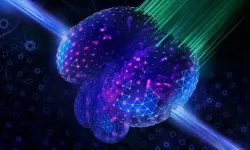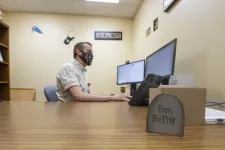(Press-News.org) A new University of Iowa study challenges the idea that gray matter (the neurons that form the cerebral cortex) is more important than white matter (the myelin covered axons that physically connect neuronal regions) when it comes to cognitive health and function. The findings may help neurologists better predict the long-term effects of strokes and other forms of traumatic brain injury.
"The most unexpected aspect of our findings was that damage to gray matter hubs of the brain that are really interconnected with other regions didn't really tell us much about how poorly people would do on cognitive tests after brain damage. On the other hand, people with damage to the densest white matter connections did much worse on those tests," explains Justin Reber, PhD, a UI postdoctoral research fellow in psychology and first author on the study. "This is important because both scientists and clinicians often focus almost exclusively on the role of gray matter. This study is a reminder that connections between brain regions might matter just as much as those regions themselves, if not more so."
The new study, published in PNAS, analyzes brain scans and cognitive function tests from over 500 people with localized areas of brain damage caused by strokes or other forms of brain injury. Looking at the location of the brain damage, also known as lesions, the UI team led by Reber and Aaron Boes, MD, PhD, correlated the level of connectedness of the damaged areas with the level of cognitive disability the patient experienced. The findings suggest that damage to highly connected regions of white matter is more predictive of cognitive impairment than damage to highly connected gray matter hubs.
Network hubs and brain function
Research on cognition often focuses on networks within the brain, and how different network configurations contribute to different aspects of cognition. Various mathematical models have been developed to measure the connectedness of networks and to identify hubs, or highly connected brain regions, that appear to be important in coordinating processing in brain networks.
The UI team used these well accepted mathematical models to identify the location of hubs within both gray and white matter from brain imaging of normal healthy individuals. The researchers then used brain scans from patients with brain lesions to find cases where areas of damage coincided with hubs. Using data from multiple cognitive tests for those patients, they were also able to measure the effect hub damage had on cognitive outcomes. Surprisingly, damage to highly connected gray matter hubs did not have a strong association with poor cognitive outcomes. In contrast, damage to dense white matter hubs was strongly linked to impaired cognition.
"The brain isn't a blank canvas where all regions are equivalent; a small lesion in one region of the brain may have very minimal impact on cognition, whereas another one may have a huge impact. These findings might help us better predict, based on the location of the damage, which patients are at risk for cognitive impairment after stroke or other brain injury," says Boes, UI professor of pediatrics, neurology, and psychiatry, and a member of the Iowa Neuroscience Institute. "It's better to know those things in advance as it gives patients and family members a more realistic prognosis and helps target rehabilitation more effectively."
UI registry is a unique resource for neuroscientists
Importantly, the new findings were based on data from over 500 individual patients, which is a large number compared to previous studies and suggests the findings are robust. The data came from two registries; one from Washington University in St. Louis, which provided data from 102 patients, and the Iowa Neurological Registry based at the UI, which provided data from 402 patients. The Iowa registry is over 40 years old and is one of the best characterized patient registries in the world, with close to 1000 subjects with well characterized cognition derived from hours of paper and pencil neuropsychological tests, and detailed brain imaging to map brain lesions. The registry is directed by Daniel Tranel, PhD, UI professor of neurology, and one of the study authors.
Reber notes that the study also illustrates the value of working with clinical patients as well as healthy individuals in terms of understanding relationships between brain structure and function.
"There is a lot of really excellent research using functional brain imaging with healthy participants or computer simulations that tell us that these gray matter hubs are critical to how the brain works, and that you can use them to predict how well healthy people will perform on cognitive tests. But when we look at how strokes and other brain damage actually affect people, it turns out that you can predict much more from damage to white matter," he says. "Research with people who have survived strokes or other brain damage is messy, complicated, and absolutely essential, because it builds a bridge between basic scientific theory and clinical practice, and it can improve both.
I cannot stress enough how grateful we are that these patients have volunteered their time to help us; without them, a lot of important research would be impossible," he adds.
INFORMATION:
In addition to Reber, Boes, and Tranel, the research team included UI researchers Kai Hwang, PhD, Mark Bowren, and Joel Bruss, as well as Pratik Mukherjee, MD, PhD, at the University of California, San Francisco.
The research was funded in part by grants from the National Institute of Neurological Disorders and Stroke, and the National Institute of Mental Health at the National Institutes of Health (NIH), and the INSPIRE T32 fellowship, an NIH-funded post-doctoral training program.
Training the artificial intelligence models that underpin web search engines, power smart assistants and enable driverless cars, consumes megawatts of energy and generates worrying carbon dioxide emissions. But new ways of training these models are proven to be greener.
Artificial intelligence models are used increasingly widely in today's world. Many carry out natural language processing tasks - such as language translation, predictive text and email spam filters. They are also used to empower smart assistants such as Siri and Alexa to 'talk' to us, and to operate driverless cars.
But to function ...
To observe the swift neuronal signals in a fish brain, scientists have started to use a technique called light-field microscopy, which makes it possible to image such fast biological processes in 3D. But the images are often lacking in quality, and it takes hours or days for massive amounts of data to be converted into 3D volumes and movies.
Now, EMBL scientists have combined artificial intelligence (AI) algorithms with two cutting-edge microscopy techniques - an advance that shortens the time for image processing from days to mere seconds, while ensuring that the resulting images are crisp and accurate. The findings are published in Nature Methods.
"Ultimately, we were able to take 'the best of both worlds' in this approach," says Nils Wagner, one of the paper's two lead ...
PHILADELPHIA-- A gene called GAS2 plays a key role in normal hearing, and its absence causes severe hearing loss, according to a study led by researchers in the Perelman School of Medicine at the University of Pennsylvania.
The researchers, whose findings are published online today in Developmental Cell, discovered that the protein encoded by GAS2 is crucial for maintaining the structural stiffness of support cells in the inner ear that normally help amplify incoming sound waves. They showed that inner ear support cells lacking functional GAS2 lose their amplifier abilities, causing severe hearing ...
Depressive symptoms are more common in teenage girls than in their male peers. However, boys' mental health appears to be affected more if they suffer from obesity. Irrespective of gender, bullying is a considerably greater risk factor than overweight for developing depressive symptoms. These conclusions are drawn by researchers at Uppsala University who monitored adolescents for six years in a questionnaire study, now published in the Journal of Public Health.
Peer-review/Observational study/People
"The purpose of our study was to investigate the connection ...
Nearly four-fifths of 16- and 17-year-olds have encountered pornographic content on the Internet
Pornography is a multibillion-dollar business. Pornographic content is virtually ubiquitous on the Internet, and surveys suggest that 25% of all searches lead to explicit content. Given the size of the market, it's not surprising that young people are drawn to such sites, which are only a couple of clicks away.
Professor Neil Thurman of the Department of Media and Communication (IfKW) at Ludwig-Maximilians-Universitaet (LMU) in Munich, in collaboration with statistician Fabian Obster (Universität der Bundeswehr München), has carried out a study on the use of pornographic sites by young people. Based on a survey involving a sample ...
Great reed warblers normally migrate by night during its month-long migration from northern Europe to Sub-Saharan Africa. However, researchers have now discovered that during the few occasions when it continues to fly during daytime, it flies at extremely high altitudes (up to 6300 meters). One possible explanation for this unexpected and consistent behaviour could be that the birds want to avoid overheating. The study is published in Science.
Most of the many millions of songbirds that migrate every year between Europe and Africa fly by night and spend the daytime hours resting and eating. Some species, which normally only fly by night, occasionally fly for over 24 consecutive ...
If you are reading this, chances are you have several other tabs open in your browser that you mean to get to eventually.
Internet browser tabs are a major source of friction on the internet. People love them. People hate them. For some users, tabs bring order and efficiency to their web browsing. For others, they spiral out of control, shrinking at the top of the screen as their numbers expand.
A research team at Carnegie Mellon University recently completed the first in-depth study of browser tabs in more than a decade. They found that many people struggle with tab overload, an underlying reason being that while tabs serve a variety of functions, ...
ITHACA, N.Y. - An 18.5 million-year-old fossil found in Panama provides evidence of a new species and is the oldest reliable example of a climbing woody vine known as a liana from the soapberry family. The discovery sheds light on the evolution of climbing plants.
The new species, named Ampelorhiza heteroxylon, belongs to a diverse group of tropical lianas called Paullinieae, within the soapberry family (Sapindaceae). More than 475 species of Paullinieae live in the tropics today.
Researchers identified the species from fossilized roots that revealed features known to be unique to the wood of modern climbing vines, adaptations that allow them to twist, grow and climb.
The study, "Climbing ...
The functions of water-dominated ecosystems can be considerably influenced and changed by hydrological fluctuation. The varying states of redox-active substances are of crucial importance here. Researchers at the University of Bayreuth have discovered this, in cooperation with partners from the Universities of Tübingen and Bristol and the Helmholtz Centre for Environmental Research, Halle-Leipzig. They present their discovery in the journal Nature Geoscience. The new study enables a more precise understanding of the biogeochemical processes that contribute to the degradation of pollutants and the reduction of greenhouse gas ...
More than ever, patients are using telehealth to ask doctors and nurses about worrying blood-pressure readings, nauseating migraines and stubborn foot ulcers. But for patients with chronic conditions, how frequent should telehealth appointments be? Can that frequency change? Under what conditions?
West Virginia University researcher Jennifer Mallow is trying to answer these questions. In a new project, she and her colleagues completed a systematic review of studies that dealt with telehealth and chronic conditions. They found that--in general--telehealth services benefitted patients more if they ...


